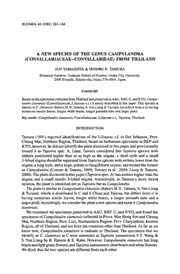
A new species of the genus Campylandra (Convallariaceae-Convallarieae) from Thailand PDF
Preview A new species of the genus Campylandra (Convallariaceae-Convallarieae) from Thailand
BLUMEA 46 (2001) 181-184 A new species of the genus Campylandra (Convallariaceae-Convallarieae) from Thailand Jun Yamashita & Minoru+N. Tamura Botanical Gardens,Graduate School ofScience,OsakaCity University, 2000 Kisaichi, Katano-shi,Osaka576-0004,Japan Summary Basedonthespecimens collected fromThailand andpreservedinAAU,BKF,C, andKYO,Campy- landra siamensis (Convallariaceae,Liliaceae s.l.) is newlydescribed in this paper. Thisspecies is similartoC.chinensis (Baker)M.N.Tamura,S.YunLiang&Turland,butdiffersfromitin having numeroussessile leaves,longerwhite bracts, longerperianthtube and largerpistil. Key words. Campylandrasiamensis, Convallariaceae,Liliaceae s.l., Tupistra,Thailand. Introduction Tamura (1991) reported identificationsofthe Liliaceae s.l. in Doi Inthanon,Prov. Chiang Mai, NorthernRegion, Thailand,based onherbariumspecimens atBKFand KYO;however,hedidnot identify theplant discussedinthispaperandprovisionally treated it as Tupistra spec. A. Later, Tamura consideredthat Tupistra species with anthers positioned higher than or as high as the stigma, a short style and a small 3-lobedstigma shouldbeseparated fromTupistra species withantherslowerthanthe stigma, along style,andalarge,peltate tofungilliform stigma, andtreatedtheformer as Campylandra (Conran & Tamura, 1998;Tamura etal., 2000; Liang & Tamura, 2000).Theplant discussedinthispaper(Tupistra spec. A)hasanthershigherthanthe stigma and a small sessile 3-lobedstigma. Accordingly, in Tamura's more recent opinion, theplant is identifiednot as Tupistra butas Campylandra. Theplant issimilartoCampylandra chinensis(Baker) M.N.Tamura,S.YunLiang & Turland, which is distributedinC andS China andTaiwan, but differs from it in having numerous sessile leaves, longer white bracts, a longer perianth tubeand a largerpistil.Accordingly, weconsidertheplantanewspecies andnameitCampylandra siamensis. Weexaminedthespecimens preserved inAAU,BKF, C,andKYO,andfoundthe specimens ofCampylandra siamensiscollectedinProvs. MaeHongSonandChiang Mai,NorthernRegion; Prov. Loei,NortheasternRegion; Prov.Chaiyaphum, Eastern Region, allofThailand,andnot from thecountriesotherthan Thailand.As faraswe know now, Campylandra siamensis isendemic toThailand.The specimens that we identify as C. siamensisatC were annotatedas Tupistra yunnanensis F.T. Wang & S.YunLiang by B. Hansen& K. Rahn. However, Campylandra siamensishas long bractsandlightgreenflowers,and Tupistrayunnanensis shortbractsandwhiteflowers. Wethinkthatthetwo species are differentfromeachother. 182 BLUMEA Vol. 46, No. 1, 2001 Fig. 1.Campylandra siamensis Yamashita & M.N. Tamura. a.Habit (T. Santisuk 1608,BKF); b. rhizome androots (M.N. Tamura & J.Yamashita 6033,KYO). J.Yamashita & M.N.Tamura: A new speciesofCampylandrafrom Thailand 183 Fig. 2.Campylandrasiamensis Yamashita & M.N.Tamura. – a-d. Flowerpositionedin lower portion ofinflorescence: a.front view;b. sideview; c.longitudinalsection;d.halfofperianth. – e & f.Flower in side view: e. middleportion ofinflorescence;f.upperportion ofinflorescence. – g-i.Stamen: g.lateral view;h.adaxial view;i.abaxial view. –j—l. Pistil:j.side view;k.front view;l.crosssection. – m-o.Bract:m. upperportionofinflorescence;n.middleportionofinflo- rescence; o.lowerportion ofinflorescence [allfrom OsakaCityUniv. cult. (M.N.Tamura10201)]. Campylandra siamensisYamashita& M.N.Tamura,spec. nov. —Fig. 1, 2 Affine Campylandro chinensi,sed foliis numerioribus sessilibus, bracteis albis longi- oribus, tubis perianthiorum longioribus, pistillis majoribusa qua diversa. —Typus: T.Santisuk 1608 (holoBKF),Thailand,N. Prov,ChiangMai,Doi Inthanon,Mae Pan waterfall, 1100m. Rhizometerete,c. 1.8cm diam.,±verticallyelongate, densely noded(space 1-2mm). Roots3-4mmdiam., densely pubescent whenyoung. Stem2-6cm long. Leaves7- 18,distichous, strap-shaped, 45-80cmlong, 2-4.8cmbroad,long acuminateatapex, marginentirebutsometimesslightly verticallyundulate,sessile,withprominentmidrib. Inflorescence aterminalspike, 3.7-7.2 cm long, 1-2.3 cm diam., 47-120-flowered, withseveralsterilebracts atapex;peduncle upto 19cmlong, c.7 mmdiam.Flowers subglobose tocampanulate, 6.5-9.2mm long, 7.8-10mmdiam.,light green;bracts linear-lanceolatetofiliform, 12-65mmlong, white,broadenedinlowerpart, minutely denticulateonuppermargin.Perianthsegments(5 or)6(or 7), fleshy, connate proxi- mally;tube3.8-6.2mmlong, thickening inward,especially sharplyprotrudingbetween filamentsalong throat;lobesovateto deltoid,2.7-4.5by 2.5-4mm,incurved.Stamens (5 or) 6 (or 7); filamentsproximally adnateto perianth tube, free part 1.3-2.3mm 184 BLUMEA Vol. 46, No. 1, 2001 long, incurved, thickening downward,c.0.8 mmdiam.atbase, inflatedabaxially at apex; anthersovoid, 1.2—1.5mm long, light yellow, introrse, positioned higher than the stigma. Ovarysubspheroidal, 2.3-3mmlong, 2.7-3.5mmdiam.,3-locular;ovules 2 per locule. Stig/na 0.5-0.7 mmthick, c. 1.5 mm diam.,sessile, 3-lobed,grooved longitudinally along apex ofeachlobe.Fruita berry, ellipsoidal, 1.1-1.4cm long, orangeatmaturity. Distribution— EndemictoThailand(N, NE,andERegions). Habitat—Evergreen or mixeddeciduousforest. On graniticrocks or sandstone, oftenby streams.Altitude600-1420m. Additional specimens examined: THAILAND:N Prov.Mae HongSon:DoiChong, 1420m (B.Hansen & T.Smitinand 12643,C); Prov.ChiangMai:KawngSan nearOmkoi (B.Hansen & K.Rahn P.1964/202,C;B.Hansen 12/3 1985,C); Mae Pan waterfall,Doi Inthanon, 1100 m (M.N. Tamura & J. Yamashita 6033,KYO; M.N.Tamura 10140,KYO);NEProv.Loei: PhuPaek, 1200m (C.F.vanBeusekom & C.Phengklai 2995,AAU,C);EProv. Chaiyaphum: NamPhrom, 600 m (C.F. vanBeusekom et al.4142,c, KYO). ACKNOWLEDGEMENTS We express our sincerethanks tothe directors and staffmembers ofthe herbaria AAU, BKF,C, and KYO.Thanks arealsodue toMr. MasayoshiUmebayashi forhis drawings. REFERENCES Conran,J.G.& M.N.Tamura. 1998,Convallariaceae. In:K.Kubitzki (ed.),TheFamilies andGenera ofVascularPlants III: 186-198. SpringerVerlag,Berlin. Liang,S.Y. & M.N. Tamura. 2000. Campylandra Baker and TupistraKer Gawler. In:Z.Y. Wu & PH. Raven (eds.),Flora ofChina,vol. 24: 235-240. Missouri BotanicalGarden Press, St. Louis and Science Press,Beijing. Tamura,M.N. 1991.Liliaceae. In:H. Koyama& N.Fukuoka (eds.), Apreliminary checklist of SpermatophytesofDoi Inthanon in Thailand II.Shoei Jr.Coll. Ann. Rep.Stud. 23: 59-66. Tamura,M.N.,S.Y.Liang& N.J.Turland. 2000.New combinations inCampylandra(Convallaria- ceae-Convallarieae).Novon 10: 158-160.
